2021 Wildlife Sightings: Incredible Findings and Photos
Welcome to the Kiawah Island Nature Program’s 2021 wildlife sightings. Here you’ll find postings from our Naturalists and island biologists, showing you what is currently in the field, as well as an archive of observations from throughout the year. We hope this archive will get you excited about the amazing and diverse wildlife found on Kiawah. Share your photos and stories with us at Kiawah_Recreation@KiawahResort.com.
November 11, 2021 ~ Even Eagles have Butterfingers
We got some exciting views of Bald Eagles on our Back Island Birding tour near Osprey Point. This young eagle very skillfully plucked a (dead) fish from the water and took it up into a nearby tree to eat. Unfortunately, fish are slippery and this eagle lost its tasty meal before finishing. Poor fellow.
October 15, 2021 ~ It was a Rock…LOBSTER!
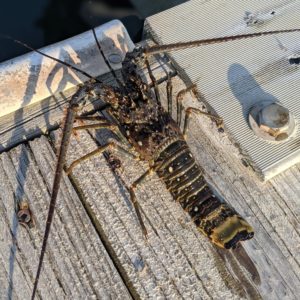
An unique and exciting crustean discovery at Mingo Point! Naturalist Peter pulled up our crabitat at Mingo Point to show some guests and guess who popped out! This is a small Caribbean Spiny Lobster which is an usual sight in the Kiawah River! Spiny Lobsters aren’t very closely related to the lobsters you normally think of and don’t have big crushing claws. They’re also called Rock Lobsters (cue The B-52s song)! This little fellow is pretty small, but full-grown adults can reach a foot and a half long with massive antennae.
October 5, 2021 ~ Bocourt Swimming Crab
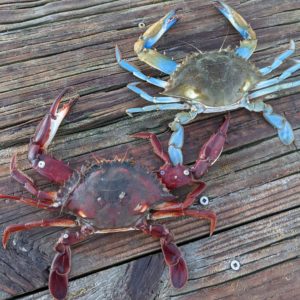
This blue crab isn’t particularly blue! Captain John Ward, one of our great fishing captains, caught this strangely colored crab in one of his traps. It’s not just a unique blue crab, but it is a close relative! This turned out to be a species called the Bocourt Swimming Crab (Callinectes bocourti) which is normally found in the Caribbean Sea near Jamaica but occasionally make their way up to us! Note that its back legs are flattened into paddles just like our local Atlantic Blue Crabs!
August 14, 2021 ~ American Alligator Track
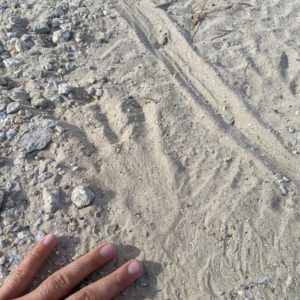 Check out the size of this track spotted on our Back Island Birding tour out at the Ocean Course! Alligators often move from pond to pond, so be on the lookout! The most obvious part of an alligator track is usually the long drag mark from their tail but this fellow left a nice four-toed foot print for us to see! Did you know alligators have four toes on their back feet and five toes on the front?
Check out the size of this track spotted on our Back Island Birding tour out at the Ocean Course! Alligators often move from pond to pond, so be on the lookout! The most obvious part of an alligator track is usually the long drag mark from their tail but this fellow left a nice four-toed foot print for us to see! Did you know alligators have four toes on their back feet and five toes on the front?
~ Naturalist Peter
June 21, 2021 ~ Smooth Butterfly Ray
![]() A beautiful surprise during our Ocean Seining tour – a Smooth Butterfly Ray! These rays have a short tail and lack a barb like most other ray species. These benthic feeders travel along the ocean floor in search for small invertebrates and small fishes. They can grow to have a wingspan of up to 4.5 feet. After admiration, the ray was released back into the water.
A beautiful surprise during our Ocean Seining tour – a Smooth Butterfly Ray! These rays have a short tail and lack a barb like most other ray species. These benthic feeders travel along the ocean floor in search for small invertebrates and small fishes. They can grow to have a wingspan of up to 4.5 feet. After admiration, the ray was released back into the water.
~Naturalist Kristen
June 8, 2021 ~ Yellow-crowned Night Herons
Some highlights from today’s Mingo Point Bird Walk: a yellow-billed cuckoo and two yellow-crowned night herons flying over! A unique sighting for this trip.
~Naturalist Peter
May 20, 2021 ~ Over the Moon!
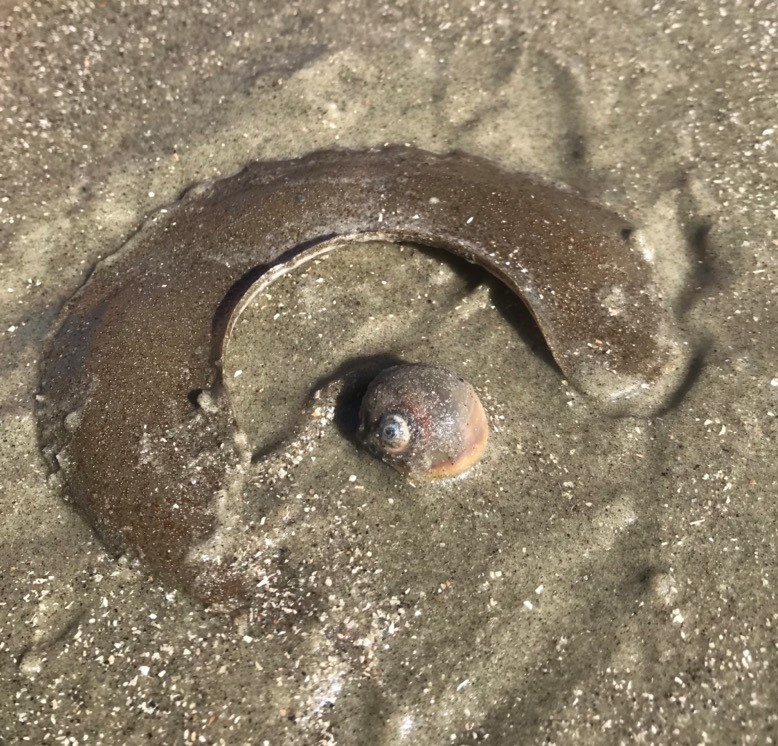 We’re over the moon (snail) about this cool find! While on a Kiawah Creatures tour, Naturalist Katy Beth stumbled upon a LIVE moon snail AND a moon snail egg case (called a sand collar) on the beach! Sand collars are often mistaken for man-made materials/pollution because of their funky crescent shape and odd rubbery texture. If you see one on the beach this summer, please don’t throw it away! Instead, you can hold it up to the light to see the thousands of tiny dots that are actually eggs (it’s mind-blowing), and then either set it back down where you found it or take it closer to the water so it won’t dry out!
We’re over the moon (snail) about this cool find! While on a Kiawah Creatures tour, Naturalist Katy Beth stumbled upon a LIVE moon snail AND a moon snail egg case (called a sand collar) on the beach! Sand collars are often mistaken for man-made materials/pollution because of their funky crescent shape and odd rubbery texture. If you see one on the beach this summer, please don’t throw it away! Instead, you can hold it up to the light to see the thousands of tiny dots that are actually eggs (it’s mind-blowing), and then either set it back down where you found it or take it closer to the water so it won’t dry out!
May 14, 2021 ~ Highlights from Back Island Birding Tour
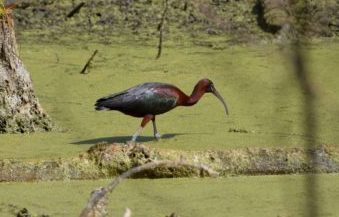 Photo by Katrena Floyd
Photo by Katrena Floyd
May 10, 2021 ~ FOS: First Loggerhead Sea Turtle Nest Laid on Kiawah!
The Kiawah Island Sea Turtle Patrol found the island’s first Loggerhead Sea Turtle nest for the 2021 season!
May 1, 2021 ~ Black-bellied Whistling Duck
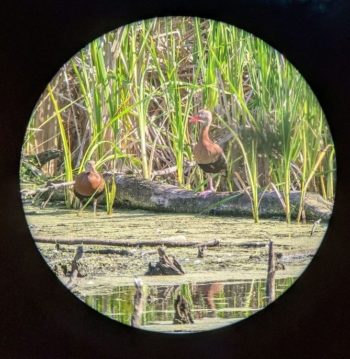 These striking Black-bellied Whistling Ducks were spotted by Naturalist Peter in the Preserve during a recent Back Island Birding tour. From Town Biologist Aaron Given: “Black-bellied Whistling Ducks have expanded their range in the southeast. They are present year-round now in SC. They only recently have been showing up infrequently but regularly on Kiawah. We have had a few scattered reports going back 8-10 years but this year there have been several sightings around Kiawah.” We hope to continue to see this beautiful species!
These striking Black-bellied Whistling Ducks were spotted by Naturalist Peter in the Preserve during a recent Back Island Birding tour. From Town Biologist Aaron Given: “Black-bellied Whistling Ducks have expanded their range in the southeast. They are present year-round now in SC. They only recently have been showing up infrequently but regularly on Kiawah. We have had a few scattered reports going back 8-10 years but this year there have been several sightings around Kiawah.” We hope to continue to see this beautiful species!
April 24, 2021 ~ Hundreds of Red Knots
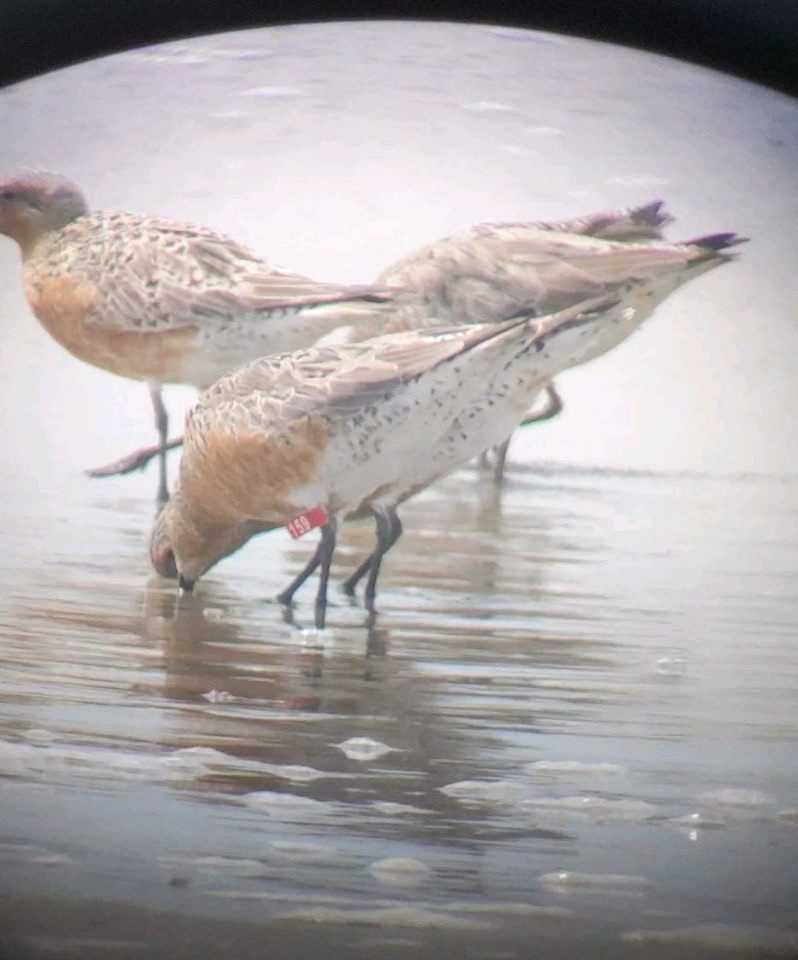 Hundreds of Red Knots were spotted on the beach front near the Sanctuary Hotel. Naturalist Peter was able to find 2 Red Knots with tags! We have already received information from one of the birds; it most likely was hatched in 2017 and was banded in South Carolina in 2019. We are still waiting to hear back about this Red Knot with the red band on its leg. Red tags usually mean the bird was banded in South America! We will update once we know the location.
Hundreds of Red Knots were spotted on the beach front near the Sanctuary Hotel. Naturalist Peter was able to find 2 Red Knots with tags! We have already received information from one of the birds; it most likely was hatched in 2017 and was banded in South Carolina in 2019. We are still waiting to hear back about this Red Knot with the red band on its leg. Red tags usually mean the bird was banded in South America! We will update once we know the location.
April 16, 2021 ~ First Manatee Sighting of the Year!
Naturalists spotted a manatee right off of the dock at Mingo Point in the Kiawah River!
April 15, 2021 ~ FOS Swallow-Tailed Kites Sighting!
Naturalist Peter spotted two Swallow-Tailed Kites near Rosebank Farms on John’s Island.
April 14, 2021 ~ Eastern Mud Turtle
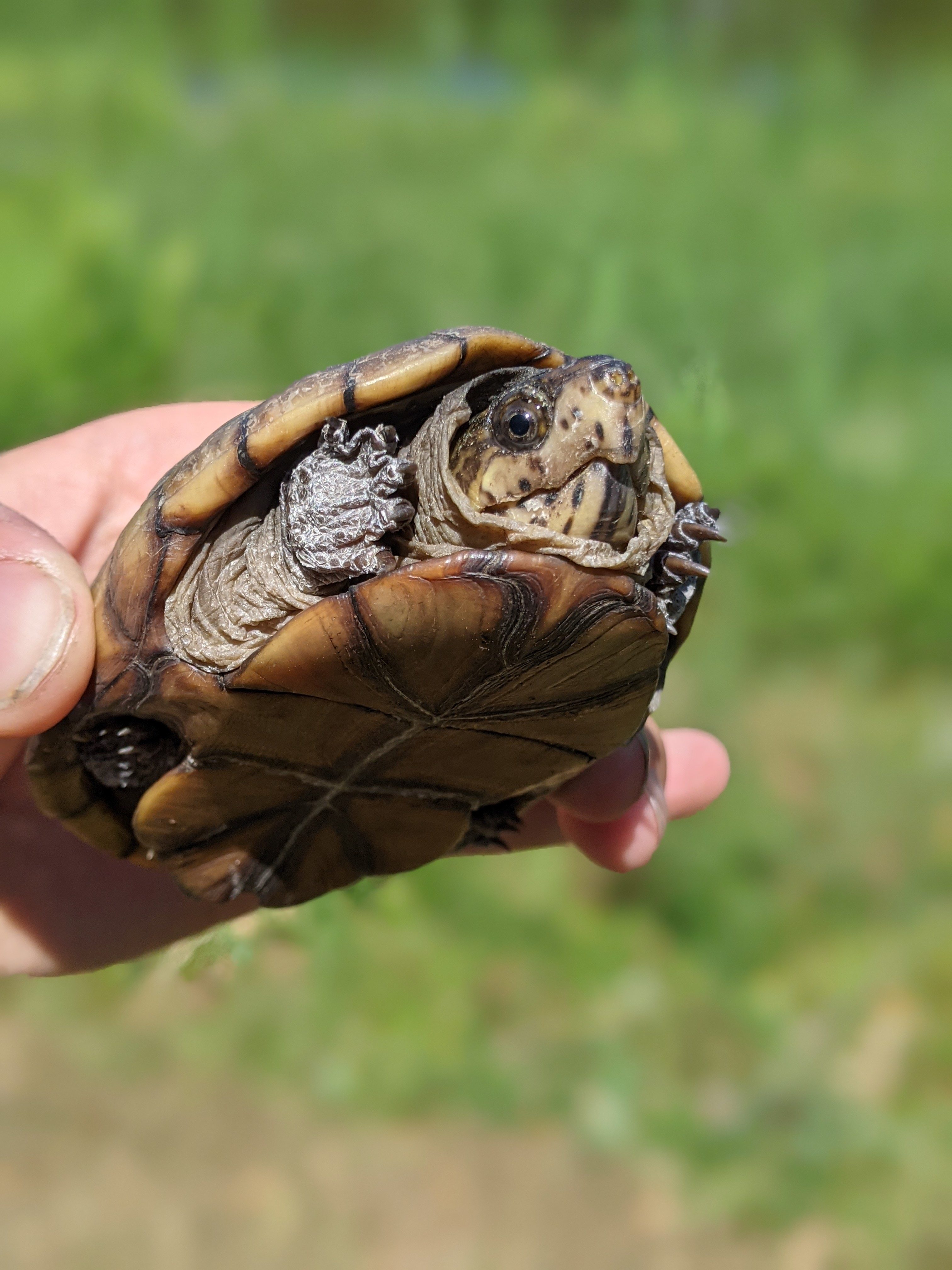 It always pays to be alert when driving around Kiawah Island because you never know who might be out and about! Naturalist Peter found this adorable Eastern Mud Turtle (Kinosternon subrubrum) crossing the road near Turtle Beach. This little fellow was only a few inches long but was likely full grown as adults rarely get past 5 inches long. It’s not uncommon this time of year to see turtles crossing the road as females may venture far and wide to find suitable nesting sites. If you come across a turtle crossing the road and (most importantly) it is safe to do so, feel free to give our friends some help to the other side of the road so they don’t end up getting injured or killed. Make sure you help them cross the road in the direction they’re already going or else they’re likely to just try and cross again! Hopefully this little turtle found a nice place to rest after its ordeal.
It always pays to be alert when driving around Kiawah Island because you never know who might be out and about! Naturalist Peter found this adorable Eastern Mud Turtle (Kinosternon subrubrum) crossing the road near Turtle Beach. This little fellow was only a few inches long but was likely full grown as adults rarely get past 5 inches long. It’s not uncommon this time of year to see turtles crossing the road as females may venture far and wide to find suitable nesting sites. If you come across a turtle crossing the road and (most importantly) it is safe to do so, feel free to give our friends some help to the other side of the road so they don’t end up getting injured or killed. Make sure you help them cross the road in the direction they’re already going or else they’re likely to just try and cross again! Hopefully this little turtle found a nice place to rest after its ordeal.
~Naturalist Peter
March 20, 2021 ~ Bonaparte’s Gull
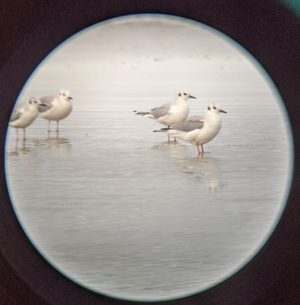 On a chilly Ocean Course bird walk this Saturday, I was happy to see a small group of Bonaparte’s Gulls resting on the beach. They are small, dainty gulls who develop pretty black hoods and beaks during the summer months, but were still showing their winter plumage, including a darkish smudge on the side of their head. Look for their pink legs as a good ID mark!
On a chilly Ocean Course bird walk this Saturday, I was happy to see a small group of Bonaparte’s Gulls resting on the beach. They are small, dainty gulls who develop pretty black hoods and beaks during the summer months, but were still showing their winter plumage, including a darkish smudge on the side of their head. Look for their pink legs as a good ID mark!
~Naturalist Peter
March 19, 2021 ~ First Black-necked Stilt Sighting of the Season!
One of the highlights of our Friday Back Island Birding was spotting our first Black-necked Stilt of the year. These are very strangely elegant birds with gorgeous black and white plumage, a dainty, slightly curved beak, and legs that are so long it is absolute bananas. When they fly, their legs trail behind them like long thin tails. Look forward to seeing them flying around Willet Pond near the Ocean Course during the summer!
~Naturalist Peter
March 18, 2021 ~ More than Birds on our Bird walk
 Even though we saw a total of 33 species of birds today on our Back Island Birding tour, our reptilian friends stole the spotlight. This big alligator was seen sunning near a pond at Osprey Golf Course as a Little Blue Heron and Tri-colored Heron waded nearby.
Even though we saw a total of 33 species of birds today on our Back Island Birding tour, our reptilian friends stole the spotlight. This big alligator was seen sunning near a pond at Osprey Golf Course as a Little Blue Heron and Tri-colored Heron waded nearby.
~Naturalist Peter
March 11, 2021 ~ Northern Parula
Today naturalists spotted a Northern Parula hopping around some Spanish Moss, signifying the start of Spring migrants! These little warblers will feed on a multitude of insects and love hanging around moss and lichen in the tree top canopies. We can’t wait for the rest of our early spring arrivals – Blue-gray Gnatcatchers, Black-necked Stilts, and Purple Martins to name a few.
March 9, 2021 ~ Sunset from Tonight’s Adult Twilight Paddle
 A beautiful spring sunset viewed on our Adult Twilight Paddle.
A beautiful spring sunset viewed on our Adult Twilight Paddle.
-Naturalist AK
March 4, 2021 ~ Sunny and 65 Degrees = Alligator Basking
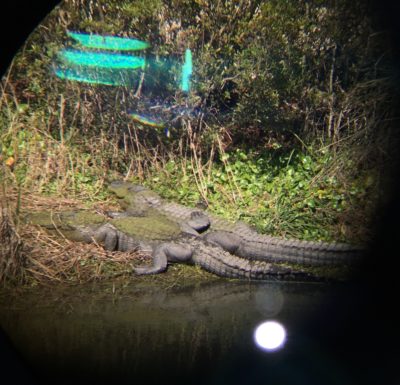 While on our Ocean Course Birding trip, we stopped to view two large alligators enjoying the nice sunny and warm weather. As we looked through our binoculars, we spotted a third gator coming out of the water to bask next to the others.
While on our Ocean Course Birding trip, we stopped to view two large alligators enjoying the nice sunny and warm weather. As we looked through our binoculars, we spotted a third gator coming out of the water to bask next to the others.
-Naturalist AK
March 2, 2021 ~ A Snapping Surprise
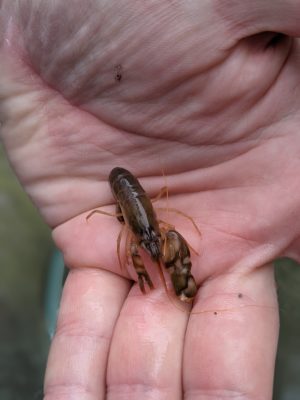 If you’ve ever listen to the sound of the marsh and heard tons of tiny clicks and snaps all around, you can thank this critter and her kin. Naturalist Peter found this handsome big-clawed snapping shrimp (Alpheus heterochaelis) hiding in the mud of the Mingo Point dock while on a Jr. Naturalist Marsh Discovery. Snapping shrimp have one small, normal claw, and one enormous specialized claw they used to SNAP. Their special snapping claws have a small peg on one part of the claw and a small socket on the other. When they slam the two parts together, the socket and peg form a tiny bubble. It’s the collapsing of this little cavitation bubble that makes the snapping sound. They use these popping bubbles to communicate, defend their territory, and cleanly sever the legs of their opponents. Be grateful you’re not their size!
If you’ve ever listen to the sound of the marsh and heard tons of tiny clicks and snaps all around, you can thank this critter and her kin. Naturalist Peter found this handsome big-clawed snapping shrimp (Alpheus heterochaelis) hiding in the mud of the Mingo Point dock while on a Jr. Naturalist Marsh Discovery. Snapping shrimp have one small, normal claw, and one enormous specialized claw they used to SNAP. Their special snapping claws have a small peg on one part of the claw and a small socket on the other. When they slam the two parts together, the socket and peg form a tiny bubble. It’s the collapsing of this little cavitation bubble that makes the snapping sound. They use these popping bubbles to communicate, defend their territory, and cleanly sever the legs of their opponents. Be grateful you’re not their size!
-Naturalist Peter
March 1, 2021 ~ Bobcat Sighting
March started off in a big way! A bobcat was seen between some Parkside Villas and a section of nearby maritime forest. The bobcat was sitting out in the open and then began to assume the pounce position with its tail twitching back and forth. Within a couple of seconds, a squirrel was nabbed and the bobcat ran into the forest with its meal with nothing left but squirrel alarm calls as the sun began to set.
-Naturalist Samantha
March 1, 2021 ~ Baby Diamondback Terrapin Hatchling Found
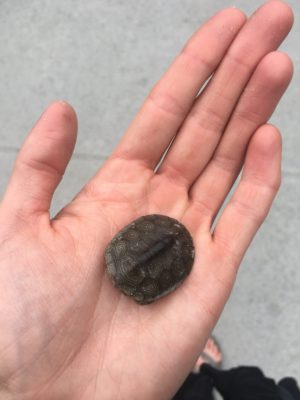 Naturalists received a call of a baby sea turtle in the surf in front of the Sanctuary Hotel. When we got there, we discovered a hatchling Diamondback Terrapin! Diamondback Terrapins usually lay nests spring though mid-summer and hatch in summer through early fall. Sometimes, hatchlings will overwinter in the nest and emerge the following spring. We believe this little guy emerged with the recent warm temperatures and was drifted out to the ocean with the higher tides. The hatchling was released at Mingo Point.
Naturalists received a call of a baby sea turtle in the surf in front of the Sanctuary Hotel. When we got there, we discovered a hatchling Diamondback Terrapin! Diamondback Terrapins usually lay nests spring though mid-summer and hatch in summer through early fall. Sometimes, hatchlings will overwinter in the nest and emerge the following spring. We believe this little guy emerged with the recent warm temperatures and was drifted out to the ocean with the higher tides. The hatchling was released at Mingo Point.
-Naturalist, Meredith
February 23, 2021 ~ White Pelican Flyover at Mingo
Naturalists counted 20 White Pelicans flying overhead at Mingo Point!
February 13, 2021 ~ Larval Lacewing
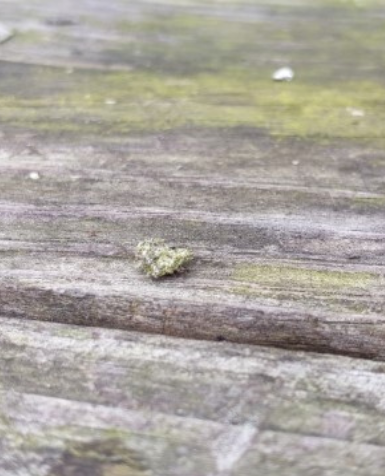 While we were sitting at a picnic table at Mingo Point, we noticed this tiny mote of moss moving slowly across the table like no moss has the right to do. These little flecks of scuttling debris are actually a fairly common sight around here and are evidence that a voracious predator of aphids in camouflaged and on the prowl. This little fellow is the larva of a lacewing (Chrysopa spp.) which decorates itself in moss, fluff, and even the bits and pieces of its vanquished prey in order sneakily hunt aphids and other tasty soft-bodied insects like a wolf in aphid’s clothing. If you look closely, you can spot a set of wicked jaws protruding out from under its mossy disguise.
While we were sitting at a picnic table at Mingo Point, we noticed this tiny mote of moss moving slowly across the table like no moss has the right to do. These little flecks of scuttling debris are actually a fairly common sight around here and are evidence that a voracious predator of aphids in camouflaged and on the prowl. This little fellow is the larva of a lacewing (Chrysopa spp.) which decorates itself in moss, fluff, and even the bits and pieces of its vanquished prey in order sneakily hunt aphids and other tasty soft-bodied insects like a wolf in aphid’s clothing. If you look closely, you can spot a set of wicked jaws protruding out from under its mossy disguise.
-Naturalist Peter
February 10, 2021 ~ Sea Cucumber
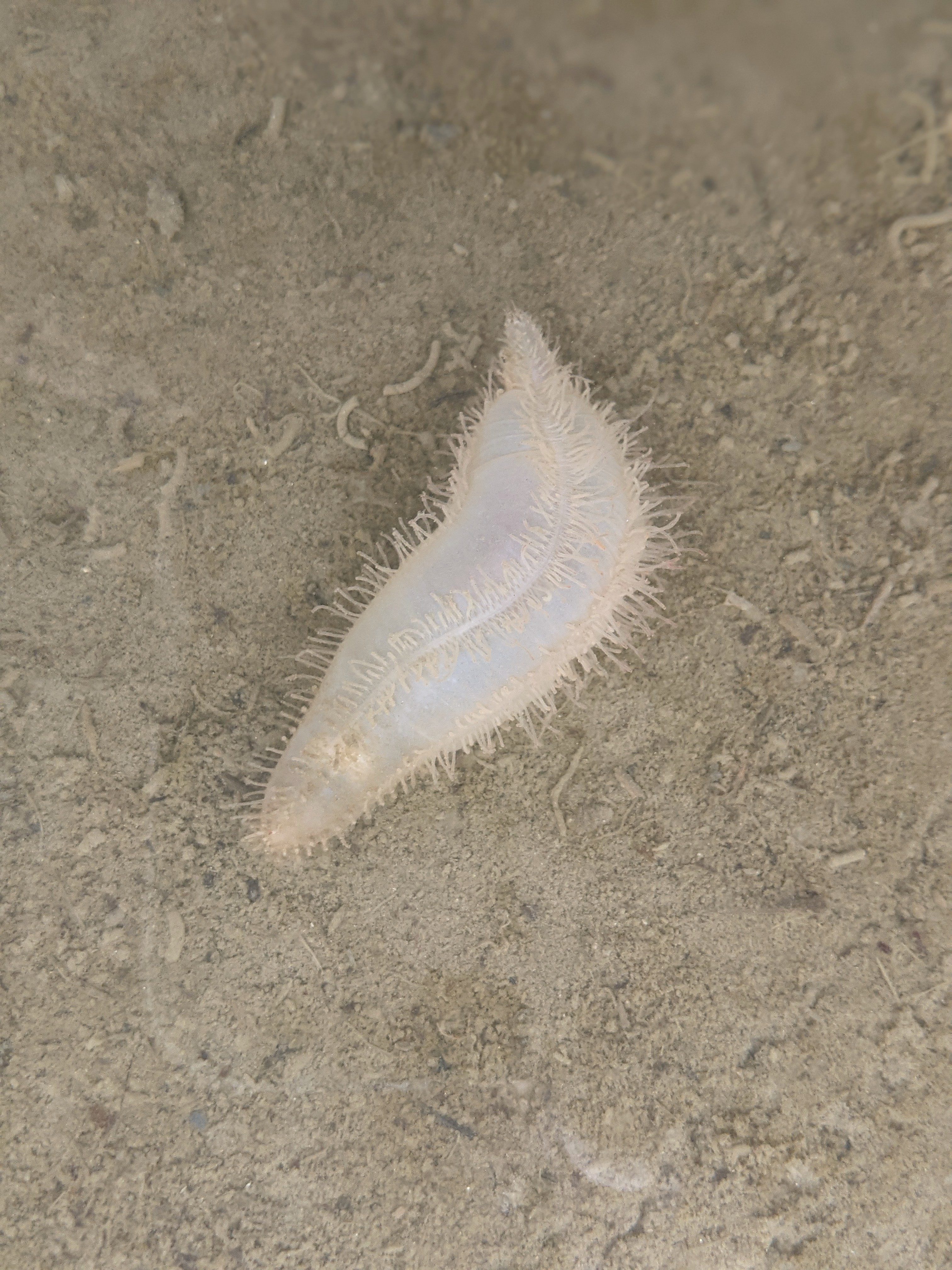 Certain times of year, thousands of chubby pink sea cucumbers get washed ashore onto the mudflats and beaches of Kiawah. These are Pentamera pulcherrima, which are squishy and slightly transparent and can be up to 2 inches long. When they’re alive, they have rows of little hair-like structures sticking out from all sides of their body. They look just like any old worm you find oozing through the mud at any given time, but sea cucumbers (don’t eat them) are echinoderms and therefore related to sea stars, urchins, and sand dollars than any old worm. In fact, the little “hairs” along its body are tube feet, just like you would find on the underside of a sea star or sand dollar.
Certain times of year, thousands of chubby pink sea cucumbers get washed ashore onto the mudflats and beaches of Kiawah. These are Pentamera pulcherrima, which are squishy and slightly transparent and can be up to 2 inches long. When they’re alive, they have rows of little hair-like structures sticking out from all sides of their body. They look just like any old worm you find oozing through the mud at any given time, but sea cucumbers (don’t eat them) are echinoderms and therefore related to sea stars, urchins, and sand dollars than any old worm. In fact, the little “hairs” along its body are tube feet, just like you would find on the underside of a sea star or sand dollar.
-Naturalist Peter
February 6, 2021 ~ Feather Report
According to my count, we saw 56 species today! Or at least those were the ones I was able to spot, identify, and remember. There were a few birds we missed that surprised me, like American Robin (which I saw a bunch a little later in the day) and nearly all the vultures and hawks. On a really good day on the island this time of year, we could probably add another dozen or so to that list. One of the highlights from this trip was the 30 or so of Red-breasted Mergansers floating about 100 yards from offshore. The Purple Finches at Mingo Point was another highlight. This year has been particularly good for spotting them on feeders at Mingo Point and Night Heron Park. Happy Birding!
-Naturalist Peter
January 30, 2021 ~ Twilight Paddle Sunset
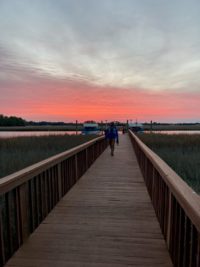 Tonight’s sunset was gorgeous!
Tonight’s sunset was gorgeous!
-Naturalist Brad
January 27, 2021 ~ Baltimore Oriole Sighting
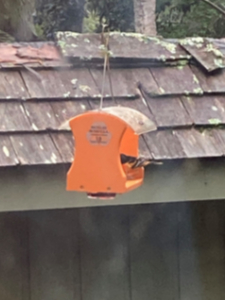 Spotted! A male Baltimore Oriole on our jelly feeder outside of the Nature Center. Baltimore Orioles usually winter in South and Central America, and historically it was unusual to see one in South Carolina during the winter. However, during the last few decades, they have been wintering along the East Coast and Southeast in greater abundance.
Spotted! A male Baltimore Oriole on our jelly feeder outside of the Nature Center. Baltimore Orioles usually winter in South and Central America, and historically it was unusual to see one in South Carolina during the winter. However, during the last few decades, they have been wintering along the East Coast and Southeast in greater abundance.
January 8, 2021 ~ 1st Back Island Birding of the Year
On our first Back Island Birding excursion of the year, we saw 41 different species! Some highlights from the trip: the massive flock of robins, piping plovers at the Ocean Course, and the Beach Evening Primrose, a yellow trailing flower on the beach.
-Naturalist Peter
January 4, 2021 ~ Annual Sea Island Christmas Bird Count
Naturalists helped with the Sea Islands Christmas Bird Count, part of a tradition that dates back to 1900 where conservationists and birdwatchers all across North America meet every winter to create a census of all birds in their area. The Sea Islands Christmas Bird Count is in its 10th year and includes areas on Kiawah and Seabrook Islands, as well as large portions of Johns and Wadmalaw Islands. This year, naturalists counted 39 different species in the Kiawah River, such as the American Oystercatcher and Marbled Godwit.